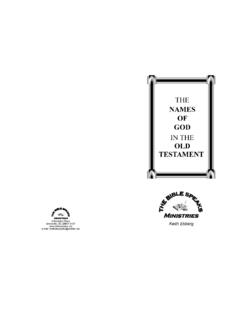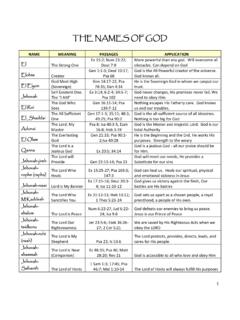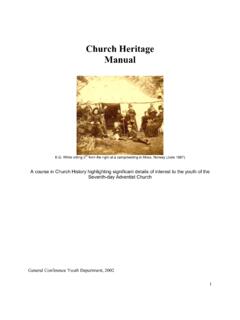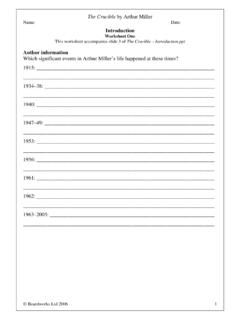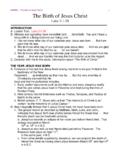Transcription of 1 Exodus Study Guide - Bible Center
1 Exodus Study Guide 1 1 TABLE OF CONTENTS OVERVIEW OF THE BOOK .. 2 PERSPECTIVE ON HORROR (1:1-22) .. 5 GOD S PROVIDENTIAL CARE (2:1-22) .. 6 GOD S KEEPS HIS COVENANTS (2:23-4:17) .. 7 DEALING WITH EXCUSES (3:11-4:17) .. 8 EVENTS ALONG THE WAY (4:18-31) .. 10 RELIGION IS FOR LAZY PEOPLE (5:1-6:9) .. 11 COULD GOD USE YOU? (6:10-30) .. 13 PLAGUES A PLENTY (7:1-11:10) .. 15 WHEN I SEE THE BLOOD (12:1-13:16) .. 17 A BAPTISM THROUGH WATER (13:17-15:21) .. 19 GRIPE, GRIPE, GRIPE (15:22-17:16) .. 20 LEADERSHIP REQUIRES LEADERS (18:1-27) .. 21 [This table is hyperlinked. You can click on a lesson title and jump to that page in your Study Guide .]
2 ] Exodus Study Guide 2 2 LESSON ONE OVERVIEW OF THE BOOK Exod us 1-40 Its Position Exodus is a part of a pentalogy, one of five works which build upon one another. The Pentateuch, penta- (five) + teuchos (books) was likely written for the benefit of the second generation to leave Egypt, the one which would be receiving the land. 1. What are the five books of Moses? 2. How does the ending of Genesis contrast with the beginning of Exodus (Gen. 50:20)? Its Application The generation that was in the wilderness and who would conquer the land along with their descendants would be able to apply some of Exodus directly, for example, the instructions on observing the Passover (12:43-51).
3 Other parts of it are a recounting of what happened in Egypt, Midian, and Mount Sinai, or as they journeyed along. This narrative s applicability is therefore in the form of lessons from the past whose principles apply to themselves and to subsequent generations of Israelites. 3. How do you think these things might apply to us? The Broad Outline of the Book Exodus divides into two parts of the story: chapters 1-18 and 19-40. The first tells how they left Egypt and came to encounter God on Mt. Sinai. The second instructs them on how they were to live with God in their midst from then on, including when they come into the land of Canaan.
4 Exodus Study Guide 3 3 Remember the Plan for Exodus the pastor presented Sunday? 4. You should skim through Exodus at least once this week and write down what general titles you would give to the following parts of the book: Chapter(s) GeneralTitle The 1-2 Deliverer 3-4 Moses 5-6 Sovereign 7-11 Passover 12-13 14-15 Journey 16-17 To Sinai 18 19 20 Covenant 21-24 25-31 Rebellion 32-34 35-39 Tabernacle 40 Later on we will give you a chart to develop a more detailed breakdown of the various parts which go into making up Exodus . The Name and the Event This book has gone by various titles in the course of its history.
5 The original Hebrew title was These are the names .. The title Exodus came to us through the Vulgate (Latin translation) following the Septuagint (Greek translation) and meant going out which reflects the going out of Deliverer ( )Sovereign (7-11)Passover (12-13)Journey (14-19)Covenant (20-31)Rebellion (32-34)Tabernacle (35-40) Exodus Study Guide 4 4 Israel from Egypt. Probably this comes from the Hebrew word yotse'ei which has a similar meaning as Exodus (3:10-11). The further back in history we go, the less we can know for certain. Hard facts become scarce as most records are either lost, biased, or impossible to fact check.
6 From the Bible , we can arrive at a possible time frame for the event known as the Exodus . 1 Kings 6:1 gives us a firm point in chronology, It was in midspring, in the month of Ziv, during the fourth year of Solomon s reign, that he began to construct the Temple of the Lord. This was 480 years after the people of Israel were rescued from their slavery in the land of Egypt. (1 Kings 6:1 NLT) If this chronology is correct, then that would date the Exodus around 1445 BC, since we know that Solomon began to reign in 971 BC. However, scholars tend to argue that the Exodus should be dated later, around 1290 The earlier date would put the Exodus event during the reign of Amenhotep II and the pharaoh of the later date would have been Rameses II.
7 The dynasties which ruled Egypt in its ancient period are grouped into three kingdoms with intermediate stages between them: Date ( ) Name Dynasty 2686-2181 Old Kingdom 3-6 2181-2061 First Intermediate 7-11 2061-1690 Middle Kingdom 11-14 1674-1549 Second Intermediate 15-17 1550-1077 New Kingdom 18-20 Looking at the Book Thematically Noel Osborn and Howard Hatton in the UBS Handbook on Exodus suggest that there are four underlying relationships which appear in sequence: Moses and Yahweh Moses and Pharaoh Moses and the People the People and Yahweh. They outline Exodus this way: The Prologue: the people s slavery (1:1 22) I.
8 The Lord s deliverance (2:1 15:21) A. The Lord and Moses: preparation of a leader (2:1 7:7) B. Moses and Pharaoh: contest for freedom (7:8 15:21) II. The people s obligation (15:22 39:43) A. Moses and the people: journey to Sinai (15:22 18:27) B. The Lord and his people: a covenant established (19:1 39:43) The Epilogue: the Lord s presence (40:1 38)2 We want to encourage you to read through the entire book of Exodus several times during the course of our Study . The more you do so, particularly at one sitting, the more you will begin to see how the various parts fit together. 1 Iain D.
9 Campbell, Opening up Exodus , (Leominster: Day One Publications, 2006), 16. 2 Noel D. Osborn and Howard A. Hatton, A Handbook on Exodus , UBS Handbook Series (NY: UBS, 1999), 3. Exodus Study Guide 5 5 LESSON TWO PERSPECTIVE ON HORROR (1:1-22) Exod us 1:1-22 A Purpose in Enlarging Us (1:1-7) 1. What does this introductory statement tell us about the descendants of Jacob? 2. What change occurs in Ex. 1:8, and how does it affect the Israelites? (1:8-11) A Purpose in Abasing Us (1:8-14) 3. What was the Egyptian s greatest fear because of Israel s increased numbers? (1:9-10) 4. What was the result of the Israelites being oppressed?
10 Why? (1:12) A Purpose in Horrifying Us (1:15-22) 5. What further measure does Pharaoh take to control the Israelites, and why does it fail? (1:15-17) 6. What was God s verdict upon what the midwives did? 7. How does Pharaoh counteract the courage of the Hebrew midwives? (1:22) 8. How would you describe the character of Pharaoh? Exodus Study Guide 6 6 LESSON THREE GOD S PROVIDENTIAL CARE (2:1-22) Exod us 2:1-22 He Rescues from Oppressors (2:1-10) 1. What irony and amazing coincidence do you find in Exodus 2:1-10? 2. What do we learn about Moses parents in Hebrews 11:23? He Rescues from Our Sins (2:11-15) 3.
